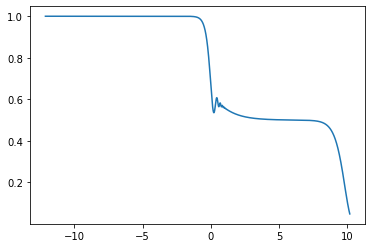Calling from Python
Using ModeCouplingTheory from Python is straightforward.
Installing
First, install juliacall through the pip package manager, with
pip install juliacallThis package allows one to call Julia from Python
In Python (only versions $\geq$ 3 are supported), run:
from juliacall import Main as jlwhich will install the latest stable version of Julia the first time it is called. Now install ModeCouplingTheory.jl, with
jl.Pkg.add("ModeCouplingTheory")To import this package in order to use it we need to run:
jl.seval("using ModeCouplingTheory")The jl.seval function lets us evaluate any Julia code from within Python.
Usage
We can now use ModeCouplingTheory.jl in Python:
# Since Python doesn't like all Unicode symbols (α, β, ∂, ...), we use standard letters:
k = 3.99999
a = 1.0
b = 0.0
c = 1.0
d = 0.0
F0 = 1.0
dF0 = 0.0
kernel = jl.SchematicF2Kernel(k)
problem = jl.MemoryEquation(a, b, c, d, F0, dF0, kernel)
sol = jl.solve(problem)
import matplotlib.pyplot as plt
import numpy as np
t = jl.get_t(sol)
F = jl.get_F(sol)
plt.plot(np.log10(t), F)
plt.show()et voilà!

See the documentation of juliacall for more information on how to call Julia from Python.